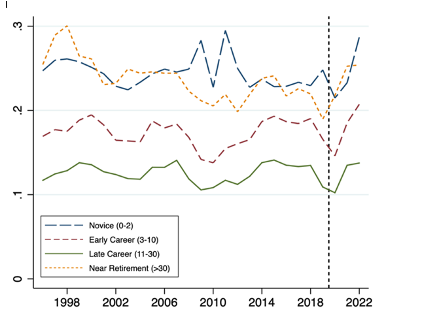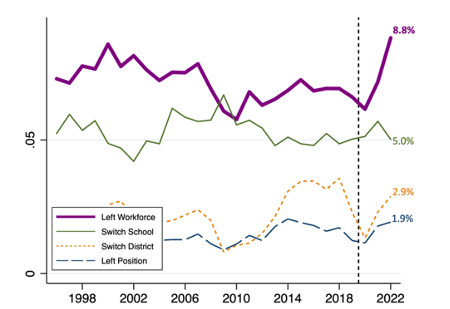Teacher Turnover

Teacher turnover is getting worse, but not in the way you might think.
“When teachers switch schools or districts, change positions, or leave teaching entirely, this counts as teacher turnover. This is one of the metrics that impact student outcomes, affecting students’ STEM achievement and disproportionately impacting low-income and BIPOC students.”
-Tana Peterman, Senior Program Officer, K-12 STEM Education
“When teachers switch schools or districts, change positions, or leave teaching entirely, this counts as teacher turnover. And teacher turnover is one of the metrics that impact student outcomes, affecting students’ STEM achievement and disproportionately impacting low-income and BIPOC students,” said Tana Peterman, senior program officer for K-12 education at Washington STEM.
New research highlights large increases in teacher turnover during the COVID-19 pandemic, primarily linked to a teacher’s years of experience. Many teachers leave the classroom as they approach retirement. But turnover is also high among early career educators—and this has a big impact on attracting and keeping a diverse teaching workforce which is crucial to helping all students succeed, especially those of color.
Washington STEM is partnering with the University of Washington’s College of Education to shine a light on this new research through a series of blogs that unpack the new findings and the potential impacts on the STEM teaching workforce.
Digging into the Data

David Knight is an associate professor at the University of Washington College of Education. He led a team of researchers, including Lu Xu, a PhD student with an interest in education policy and a love of statistics, as they dug into the data to understand the reported reasons for this spike in teachers leaving the profession. Using the Washington Office of Superintendent of Public Instruction’s (OSPI) personnel database, they looked at 1.6 million data points from 160,000 unique teachers across 2,977 schools in 295 districts. With this treasure trove of data, Xu and others used statistical regression models to consider and control for multiple factors that can affect turnover, including school environmental factors, individual demographics, and years of teaching experience.
Xu said, “Using publicly available data, we wanted to get a sense of the rate at which teachers are leaving in the post-pandemic world. Ideally, this policy brief will help policymakers make informed decisions to help stabilize the teaching workforce—and have better student outcomes.”

The research showed that attrition rates increased among novice teachers, and among those leaving the K-12 system entirely. The data showed that before 2012, most turnover was due to teachers switching schools. And since then, as a greater percentage of the teaching workforce neared retirement age, a greater proportion of teacher-leavers exited the K-12 system entirely, most for retirement. But with the pandemic, novice teachers were also part of the spike in leavers who left the profession rather than seeking a new teaching position or taking on new leadership roles (see top purple line in graph at right).
Further, the pandemic has altered the main source of annual teacher attrition, with a greater proportion leaving the teacher workforce altogether. Before the pandemic started, statewide turnover totals dipped down to 15%, but by the end of 2022 total turnover had climbed to 18.7%. As schools struggled through the pandemic, this loss of teachers—arguably the most crucial contributors toward student achievement —drew significant attention.
Losing novice teachers
It should come as no surprise that decades of research find that teachers are more likely to leave their jobs when 1) they receive limited administrative support or opportunities for professional growth, 2) when they enjoy fewer collegial relationships, and 3) when their salaries are lower than surrounding school districts.
The UW researchers used statistical models to better understand the factors associated with teacher turnover. Prior research shows that a teacher’s individual characteristics (teacher race/ethnicity, gender, years of experience, highest degree), and their school environmental factors (student population demographics, level of poverty, school size, grade levels) are both strongly correlated with where teachers choose to work. These factors influence teachers’ career path decisions, and have a direct effect on job satisfaction and turnover rates. But less research exists about how these factors changed during the pandemic.
Knight said, “We had a sense of the most common predictors of teacher turnover— career stage and school working conditions— but we weren’t sure how those patterns would change during the pandemic.”
The most significant findings include:
- The percentage of teachers leaving their school each year reached almost 20% during the COVID-19 era including about 9% who left the workforce altogether.
- Students of color and lower-income students are disproportionately impacted by high teacher turnover. Students of color are 1.3 times more likely than their white peers to attend a school with chronic teacher turnover—schools with more that 25% turnover for three consecutive years.
- Turnover is highest among novice teachers, a group that is more racially diverse than the statewide teacher workforce.
- Female teachers are 1.7% more likely to leave than male teachers.
- Black and multi-racial teachers are significantly more likely to leave teaching compared to their peers who identify as white, Asian, Hispanic, and Pacific Islander.
Xu pointed out that by controlling for these variables, the research has shown that teacher turnover is actually not a statewide issue, but that it is highest in schools that rely on novice teachers.
Xu pointed out that by controlling for these variables, the research has shown that teacher turnover is actually not a statewide issue, but that it is highest in schools that rely on novice teachers. This is found in small rural schools as well as in urban districts with high poverty rates and higher percentages of BIPOC students.
Knight added, “Although turnover happens in schools across the state, it happens in certain pockets. And if turnover rates increase further, the resulting complications could be particularly severe for those schools and areas already grappling with staffing difficulties.”
Knight and his team believe that if the factors that drive turnover are better understood, policymakers will be able to create solutions to support and stabilize the teaching workforce, so students enjoy the strong, consistent relationships with their teachers that undergird learning.
Overall, the researchers offer these policy recommendations:
- Develop retention strategies for schools with higher turnover rates, including efforts to create more inclusive and supportive work environments.
- Target state and district resources to districts and schools with higher teacher turnover.
- Leverage existing state resources to identify needs, including Washington’s Educator Equity Data Collection tool.
***
This STEM Teaching Workforce blog post was written in partnership with researchers from the University of Washington’s College of Education, based primarily on their research into the COVID-19 pandemic’s impacts on the educational workforce.